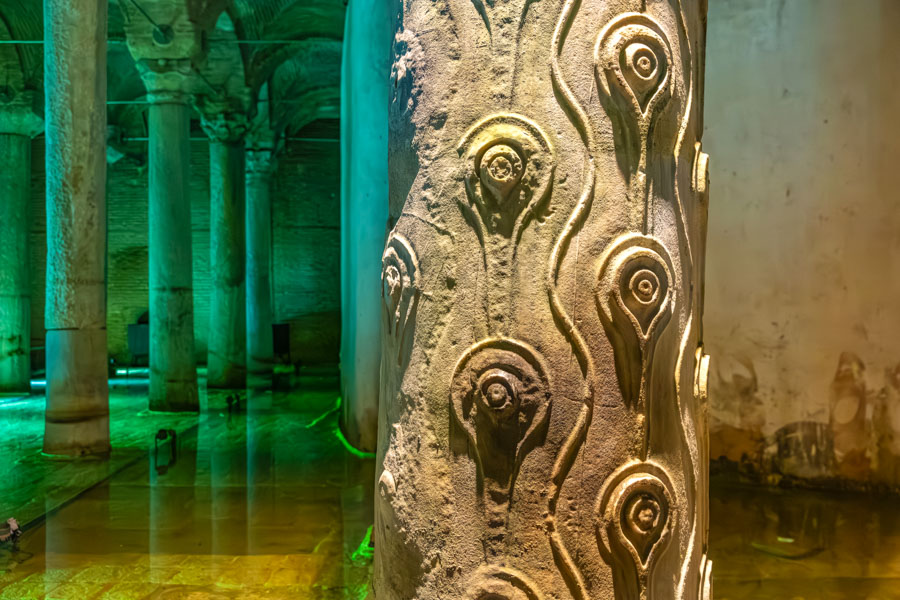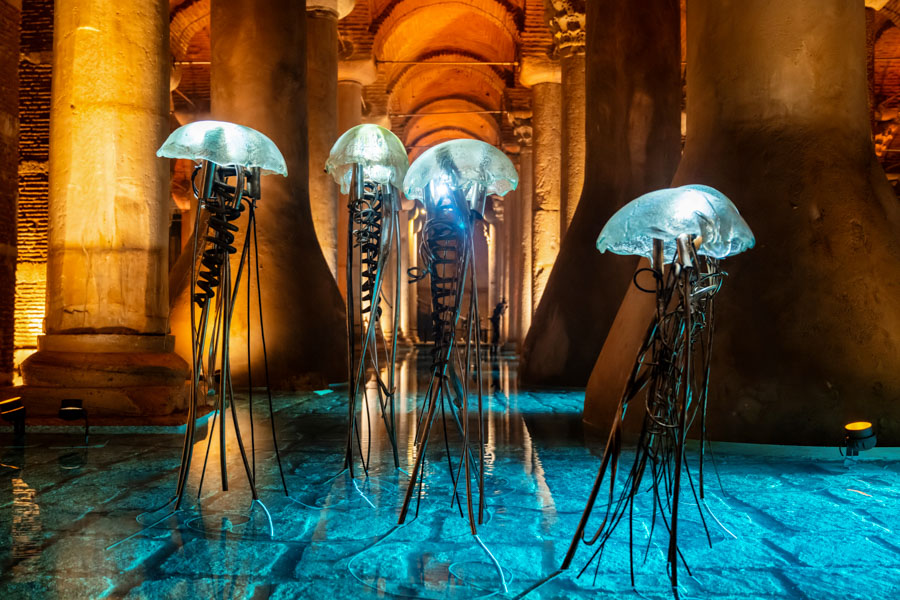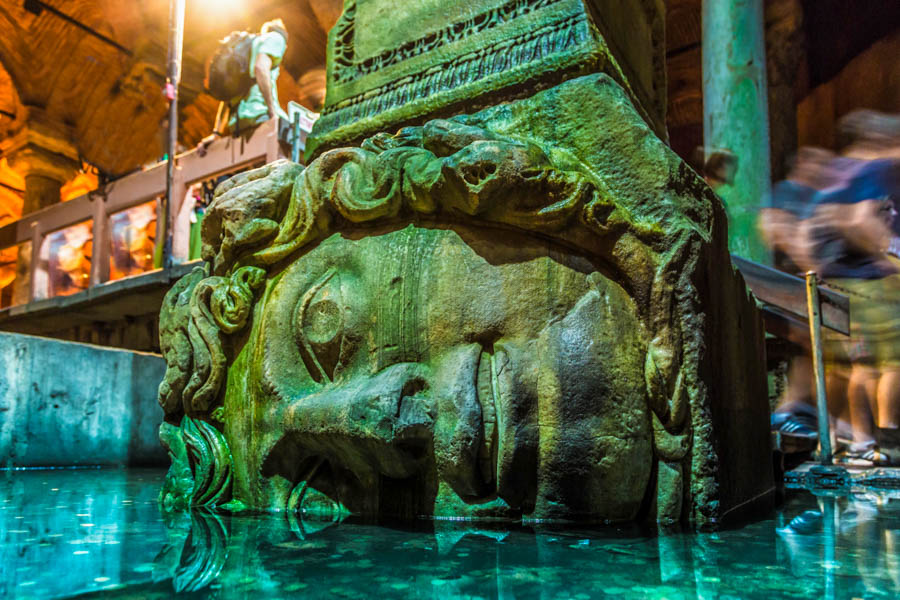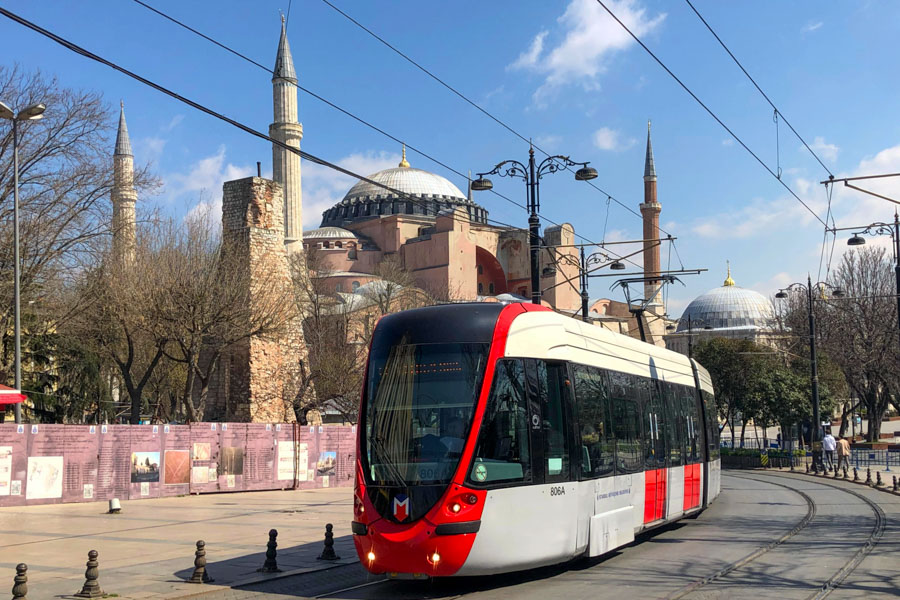
Among the most iconic attractions in Istanbul, Basilica Cistern fosters deep insights into Constantinople, Byzantine engineering and ancient water supply systems. Built by Emperor Justinian I between 527 and 565, it remains the largest surviving underground cistern around the world. Locals call it Yerebatan Sarayı, the Sunken Palace, for its rows of weeping column bases rising from the water.
It once held up to 80,000 tons of water, collected through channels from the Belgrade Forest and the Hadrianus Aqueduct. It supplied water for the Great Palace and nearby buildings when the city still went by another name. Covering nearly 10,000 square metres, its brick walls and thick mortar have been standing firm for fifteen centuries.
Inside, the layout arranges 336 marble columns, each nine metres tall, into 12 rows at regular intervals. Some are plain, others carved in the Corinthian style, each taken from older structures and reused to hold up the domed ceiling.
Today, you can walk on raised platforms above still and shallow water. Medusa’s stone heads rest under two of the columns where one is sideways and another - upside down. The air is cool and heavy, while lights shimmer on the ceiling. What was once a hidden reservoir now feels like an underground cathedral raising our comprehension of the ancient city.
Basilica Cistern Tours

Istanbul Basilica Cistern sits under the heart of Sultanahmet square, close to Hagia Sophia and the Blue Mosque. Cisterna Basilica is a must while exploring historical sites in Istanbul and interesting things to do in Istanbul.
Basilica Cistern tours usually begin with a walk down a stone staircase into the dim, underground cistern. The reflections of the Basilica Cistern columns on the water and the lights make the space extremely photogenic.
Guided tours Basilica Cistern options include:
- Storytelling about Basilica Cistern rich history
- Insights into Constantinople cistern engineering
- Legends behind the Basilica Cistern Medusa heads
Basilica Cistern History
This old cistern in Turkey (Türkiye) built in the 6th century held about 80,000 cubic metres of water for the Great Palace. Byzantine Emperor Justinian I's plan was to rebuild Yerebatan Sarayı following the Nika Riots in 532. Its materials came from older Roman temples. This practical and symbolic choice preserved pieces of earlier architecture.
After the Byzantine Era and the Ottoman conquest in 1453, it supplied Topkapı Palace before falling out of use. The underground chamber was forgotten about until French researcher Petrus Gyllius found it again. In the 16th century he followed clues from villagers who caught fish in holes in their floors.
Ottoman Empire restorations in the 18th and 19th centuries helped maintain the underground cistern Istanbul structure. In the late 20th century, it reopened as the Basilica Cistern Museum. A major restoration in 2020–2022 improved walkways, lighting, and earthquake resistance. This preserved the cistern as one of the most significant Byzantine empire monuments in Istanbul.
Basilica Cistern Architecture

The size alone is impressive at about 138 by 65 metres creating a massive underground hall. Brick vaults distribute the weight evenly, and the thick waterproof mortar kept the stored water clean and secure for centuries.
You can see column styles ranging from ornate Corinthian to Ionic, while others appear very simple. This variety shows that builders took many from earlier Roman structures. In the northwest corner, the famous Medusa heads always draw attention because builders set them sideways and upside down. Their purpose is under debate till today.
- Size & Capacity
Roughly 138 x 65 metres, the cistern covers about 10,000 square metres. Strong brick walls with waterproof mortar held the massive water supply.
- Support System
336 columns support the vaulted ceiling distanced 5 metres apart.
- Column Styles
A mix of Corinthian, Ionic and some plain shafts, all reused from earlier structures.
- Floor & Structure
Reinforced with durable mortar and modern supports to protect the original surface while keeping it safe for visitors.
- Lighting
Updated Basilica Cistern lights highlight reflections and create a calm, cinematic atmosphere. Perfect for visitors wanting Basilica Cistern images.
- Heads of Medusa
The famous Basilica Cistern Medusa heads remain a highlight. Their orientation still raises questions, adding a touch of myth to engineering genius.
Inside the Yerebatan Sarnıcı

When you visit Basilica Cistern today, you’ll find a synthesis of history and contemporary art. Exhibitions use reflections, water, and the underground environment to create immersive experiences while respecting the original architecture.
Performances, sound installations, and temporary artworks turn this underground cistern Istanbul into a cultural venue without changing its structure. This becomes one of the most creative things to do in Istanbul beyond the usual museums.
Interesting Facts about Basilica Cistern Istanbul Turkey

- One unique detail of the Basilica Cistern is its mix of recycled columns and carved bases. These features come from older Roman buildings.
- The famous Medusa heads at the base of two pillars attract many visitors and photographers. They have become some of the most shared photos of the Basilica Cistern online.
- Another interesting fact is that the temperature inside the cistern stays cool. This happens even on the hottest summer days. This is one reason that people used it as a secret refuge during wars.
- The sound of dripping water and dim Basilica Cistern lights create a peaceful, almost otherworldly mood.
- The Basilica Cistern served as a filming site for the 1963 James Bond film From Russia with Love. In the movie, the underground chamber represents a Soviet consulate, where Bond and Kerim Bey manoeuvre a boat.
- Part of the UNESCO-listed Historic Areas of Istanbul, recognised for its role in the ancient water system.
- Today, the site functions as a Basilica Cistern museum with rotating art installations and concerts. This proves that an ancient cistern in Turkey can still inspire creativity.
Before you visit the Basilica Cistern, check Basilica Cistern opening hours, entrance fee, and ticket price. Additionally, join one of the guided tours Basilica Cistern for a deeper look at its hidden stories.
Basilica Cistern Tickets & Prices

Basilica Cistern entrance fee varies depending on the visiting hours, tour types and nationalities.
Standard Entry Tickets
- Regular admission to the Basilica Cistern Museum (underground cistern Istanbul) can be purchased on-site or online. Foreign visitor entry fees in recent listings are at around 30 USD for daytime entry (from about 09:00 to 18:30). For evening/night access (from about 19:30 to 22:00) it's 50 USD.
- Some ticket counters list discounts for Turkish citizens, children under 7, and persons over 65.
- Entry tickets let you visit the columns and Medusa heads. You can also access all visitor areas of the Basilica Cistern in Istanbul, Turkey. This is valid during regular opening hours.
Skip-the-Line & Audio Guide Tickets
- A popular choice is the skip the line tickets allowing a quick QR entry avoiding long lines. They might include an audio guide available in English, Spanish, German, French, and Italian.
- These tickets often cost around 40 USD or equivalent in euros for a one-day adult ticket.
Guided Tour Tickets
- Visitors who prefer a live guide can enjoy guided tours with skip-the-line entry. Typically these tours last about 30 minutes, led by a licensed English-speaking guide.
- Guided tours come in at roughly 45 USD or the equivalent in other currencies in recent listings.
Combo Tickets (Multi-Attraction Packages)
- The Basilica Cistern often features in combo deals covering Hagia Sophia, Blue Mosque, Topkapi Palace, or combinations thereof. These Basilica Cistern ticket packages allow one purchase to cover multiple historical sites in Istanbul, usually less expensive than buying each separately.
- Example: a combo ticket for Basilica Cistern + Hagia Sophia with skip-the-line access and audio guide. Another: a 3-site combo including Basilica Cistern, Blue Mosque and Hagia Sophia with a licensed guide.
Important Buying & Visiting Information
- Buying online in advance is strongly recommended to avoid long queues, especially during high season.
- Check opening hours before you book, even though standard access is typically from 09:00. The last entry is from approximately 7:30 PM to 10:00 PM, still it may differ on some dates.
- When using combo tickets, verify how long they remain valid and the conditions.
How to Reach the Basilica Cistern Location

Yerebatan Sarnıcı lies in the heart of the Sultanahmet district, just a few steps away from Hagia Sophia. Basilica Cistern location makes the site easy to reach from almost anywhere in the city.
- If you’re using public transport, the most convenient way is by tram. Take the T1 Bağcılar–Kabataş line and get off at Sultanahmet Station. From there, it’s only a 2-minute walk to the entrance on Yerebatan Caddesi. For those coming from Taksim or Galata, you can take the funicular (F1) from Taksim Square to Kabataş, then transfer to the T1 tram.
- Visitors coming by bus or Marmaray train can get off at Sirkeci Station, a 10-minute walk to the Cistern.
- Taxis and apps like BiTaksi or Uber remain a widely available option for a quick ride to this attraction.
- Since the Hagia Sophia sits next to Basilica Cistern, many visit both sites on the same day. The area is pedestrian-friendly, so exploring nearby historical sites in Istanbul is easy and pleasant.
Check the Basilica Cistern opening hours before you go. The best time to visit Basilica Cistern is early morning or late afternoon. So, you will avoid the crowds and enjoy its peaceful atmosphere.

